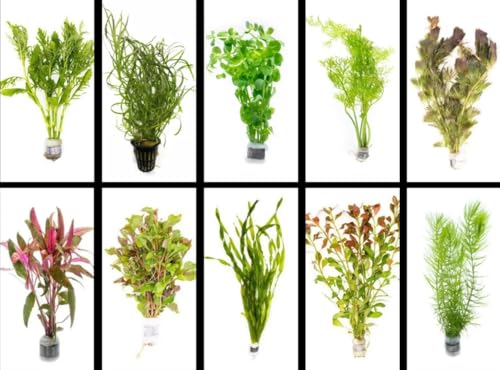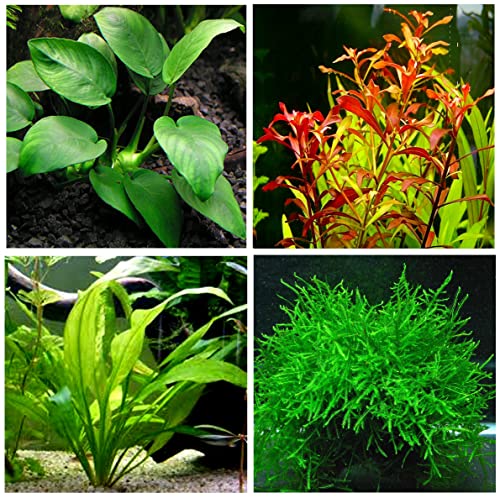10 Best Beginner Plants For Aquariums [2025]
This post contains affiliate links. As an Amazon Associate, we earn from qualifying purchases.
Choosing the best beginner plants for aquariums can be a daunting task, especially with the plethora of options available on the market. Many novice aquarists struggle to find plants that thrive in their specific conditions, leading to frustration and wasted time. To simplify this process, we have meticulously shortlisted 10 beginner-friendly plants based on ease of care, adaptability, and aesthetic appeal. Our curated list not only saves you time but also alleviates the hassle of trial and error, allowing you to create a flourishing aquatic environment with confidence.
Top 10 Beginner Plants For Aquariums In The Market
Beginner Plants For Aquariums Review
- 🌱 Curated by Experts: Each pack includes an assorted mix of hardy, low-maintenance aquatic plants professionally selected by our growers.
- 💧 Beginner Friendly: Thrives under low to medium light — no CO₂ or fancy substrate required.
- 🐠 Safe for All Aquariums: 100% fish, shrimp, and snail safe — great for betta tanks, community tanks, and planted aquascapes.
- 🔆 Fast-Growing & Low Upkeep: Provides oxygen, improves water quality, and reduces algae naturally.
- ✅ Nursery Quality Guarantee: Pest-free, snail-free, and sustainably grown in a controlled environment.
- Live Freshwater Aquarium Plants - 5 Assorted Bundle Rooted for Fish Tanks - (Grower's Choice) Beginner Friendly
- Easy live aquarium plant species for any freshwater aquarium.
- Create a natural habitat in your aquarium for your fish and invertebrates
- Provide natural resting and hiding places for your smaller fish and invertebrates
- Aquarium plants will convert carbon dioxide into oxygen which makes for a healthier environment for your aquarium inhabitants
- Echinodorus bleheri from South America is undemanding and beautiful, and becomes 20-50 cm tall.
- A nutritious bottom promotes growth, but the plant needs pruning to prevent it depriving plants underneath of light.
- Echinodorus bleheri does well even in poorly illuminated aquariums, as it grows towards the light. It is a hardy and easy solitary plant for both beginners and the more experienced with quite large aquariums. It has been sold under the name "Paniculatus".
- Great selection of live plants for small mini- or nano tanks!
- Live Freshwater Aquarium Plants - 5 Assorted Potted for Fish Tanks - (Grower's Choice) Beginner Friendly
- Our plants come in multiple colors such as green, red, and purple, giving you endless possibilities to create a visually stunning and diverse underwater environment.
- Our plants are freshly cut and ready to be planted in your aquarium
- They help to oxygenate the water, absorb excess nutrients, and provide hiding places for fish and other aquatic creatures.
- Great selection of live plants for small mini- or nano tanks! If you have larger tanks - take advantage of our B u y 2 Get 1 F re e d eal
- Super easy, beginner Live Aquarium Plants! Three different types! Instantly beautify your small tank with these beautiful and healthy beginner plants! Make your tank look truly natural!
- Live aquarium plants will saturate water with oxygen, provide a shelter for smaller fish, remove toxic waste and transform your tank with constantly changing underwater landscape! B U Y 2 G E T 1 F R E E deal!
- Perfect for small tanks with peaceful community fish - Betta, guppies, platies, angelfish, tetras, barbs etc.
- These easy plants will also grow fine in summer ponds! B u y 2 G e t 1 F r e e deal!
- Anubias Nana is one of the most popular aquatic plants loved by both beginners and experts alike, and will instantly give your aquarium, paludarium, or terrarium a lush and natural appearance.
- Known for its smaller stems, rich green tone, and pointed leaves, this aquatic plant is great for filling up open space and can be placed in the midground or background of your tank.
- Ships 4-6" tall rooted in wool which should be removed prior to planting. Gently squeeze the pot, peel back the wool, rinse, and plant! Keep the rhizomes above your substrate or the plant can begin to rot.
- Will thrive attached directly onto hardscape such as driftwood and stones using thread or aquarium glue and will grow fine either immersed in a humid environment or fully submerged.
- Easy Care - Anubias have low light requirements, can benefit from regular fertilization, and do not require additional Co2 making them a great choice for beginners to live aquatic plants.
- IMPORTANT: Please note that during times of extreme weather, live plants will can suffer due to extreme temps. During winter, do not order live plants when temperatures are expected to go below 30F at the lowest point during the day.
- LIVE AQUARIUM PLANT - 6 Jungle Val aquatic plants perfect beginner plants very easy to grow
- LIVE ARRIVAL - We stand behind live arrival on all of our livestock provided you don't order when temperatures are expected to go below 30F at the lowest point during the day. If a plant ever arrives dead send us a clear photo of the plant in the unopened bag and and we will replace once verified.
- We do our very best to respond fast and ship happy, healthy plants. If you have any questions or concerns please message us we are always happy to help!
- Jungle val plants are easy to grow and are quite robust. Please keep in mind they tend to melt back a fair amount initially when transplanted so expect that. It's best to trim the tops and then plant as normal when you receive them.
- WEATHER WARNING - THESE ARE LIVE PLANTS. IF YOUR REGION IS FREEZING (BELOW 32F) OR EXTREMELY HOT (ABOVE 90F), PLEASE REFRAIN FROM ORDERING AS EXTREME WEATHER WILL DAMAGE THEM DURING SHIPPING. WE WON'T REFUND OR REPLACE ORDERS PLACED IN FREEZING REGIONS. IF AN ORDER IS PLACED TO A FRIGID REGION, WE WILL HOLD THE ORDER UNTIL IT IS SAFE TO SHIP
- Easy live aquarium plant species for any freshwater aquarium. You get 10 grown plant bunches, 1 of each species of ranging from 6 to 12 inches in height with the exception of the Lobelia Cardinalis which is about 3". Plants are grown in the US and subject to US standards for aquatic plants. Each of our plant bunches have several stems. Please note that some plants will take several weeks to transition to its aquatic form as some are grown emersed
- Perfect for 10+ gallons aquariums. Create a natural habitat in your aquarium for your fish and invertebrates
- Provide natural resting and hiding places for your smaller fish and invertebrates
- Create a natural biological filter in your tank by having plants absorb nitrates from waste
- Live Freshwater Aquarium Plants - 3 Assorted Potted for Fish Tanks - (Grower's Choice) Beginner Friendly
- Our plants are freshly cut and ready to be planted in your aquarium
- (Grower's Choice) Beginner Friendly
Our Review Process
To ensure you get reliable product recommendations, we follow a detailed review methodology that includes:
- Market Research: Scanning best-selling and trending products in this category.
- User Feedback: Reviewing customer reviews, star ratings, and complaints.
- Hands-On Testing: Trying select products ourselves when feasible.
- Feature Comparison: Evaluating specs, durability, pricing, and safety.
- Expert Opinions: Consulting with niche experts or credible reviewers.
We independently select the top 10 options based on value, quality, and usability. To learn more, visit our detailed review process.
Key Considerations Before Buying Beginner Plants for Aquariums
1. Light Requirements
Different aquatic plants have varying light needs, which play a crucial role in their growth and health. Before purchasing, assess the lighting conditions of your aquarium. Low-light plants like Java Fern and Anubias are suitable for beginners and can thrive under modest lighting, while high-light plants may require specialized lighting systems to flourish.
2. Water Conditions
Understanding your water parameters is essential when selecting aquarium plants. Factors such as pH, hardness, and temperature can significantly impact plant health. Most beginner-friendly plants adapt well to a range of conditions, but it’s still vital to ensure that your aquarium’s water is compatible with the plants you choose.
3. Growth Rate
Beginner plants can vary in growth rates. Some may grow quickly and require regular trimming and maintenance, while others grow slowly and can be left to flourish with minimal intervention. Consider how much time you can dedicate to plant care when selecting your plants.
4. Plant Size and Tank Space
Evaluate the size of your aquarium and how many plants you can realistically accommodate. Some species can grow quite large, which may not be suitable for smaller tanks. Choose plants that will fit well within your aquarium’s dimensions and leave adequate space for fish and other inhabitants.
5. Compatibility with Fish and Inhabitants
Some aquatic plants may not be compatible with all fish species. For instance, certain fish may nibble on or uproot delicate plants. Research the compatibility of your chosen plants with your fish and other tank inhabitants to ensure a harmonious environment.
6. Substrate Choice
The substrate in your aquarium can influence plant growth significantly. Some plants thrive in nutrient-rich substrates, while others can do well in standard gravel. Consider the type of substrate you have or plan to install and choose plants that will thrive in those conditions.
7. Maintenance Level
Different aquatic plants require different levels of care. Some might need regular fertilization, while others can survive on minimal care. As a beginner, it’s advisable to select low-maintenance plants that will allow you to enjoy your aquarium without overwhelming you with upkeep.
8. Cost
Plant prices can vary widely based on species, size, and availability. Consider your budget when choosing plants. While some beginner plants are quite affordable, others may be pricier. Balancing cost with the quality and adaptability of the plants is crucial for a successful aquarium setup.
FAQs
What are the best beginner plants for aquariums?
Some of the best beginner plants for aquariums include Java Fern, Anubias, Amazon Sword, and Marimo Moss Balls. These plants are hardy, easy to care for, and can thrive in a variety of water conditions.
How much light do beginner aquarium plants need?
Most beginner aquarium plants require moderate lighting. A typical aquarium light that provides around 10-12 hours of light per day is usually sufficient. However, specific light requirements can vary depending on the plant species, so it’s important to research the needs of the plants you choose.
Do I need to add fertilizers for my aquarium plants?
While many beginner plants can survive without fertilizers, adding a liquid fertilizer specifically designed for aquarium plants can promote better growth and health. Look for a balanced fertilizer that includes essential nutrients like nitrogen, phosphorus, and potassium.
How often should I change the water in my planted aquarium?
It’s generally recommended to change 10-20% of the water weekly in a planted aquarium. Regular water changes help maintain water quality by removing toxins and replenishing essential nutrients that plants need to thrive.
Can I use gravel or sand as substrate for my aquarium plants?
Yes, both gravel and sand can be used as substrates for aquarium plants. However, plants that require rooting may do better in a nutrient-rich substrate or a layer of fine gravel or soil mixed with gravel. Additionally, some plants can thrive in floating or anchored conditions, so substrate choice can depend on the specific plant species.
Do aquarium plants help with water quality?
Yes, aquarium plants play a significant role in improving water quality. They absorb harmful chemicals like ammonia and nitrates, release oxygen, and provide shelter for fish and beneficial microorganisms, contributing to a healthier aquarium ecosystem.
How do I propagate aquarium plants?
Propagation methods vary depending on the plant species. Common methods include cutting stem plants and replanting the cuttings, dividing root systems of larger plants, or allowing certain plants to produce offsets or runners. Research the specific propagation technique for the plants you have.
Are there any common pests or problems with aquarium plants?
Yes, common pests such as algae, snails, and certain insects can be problems for aquarium plants. Algae can be managed through proper lighting, nutrient balance, and regular maintenance. Snails can often be controlled by introducing natural predators or removing them manually. Always monitor your plants for signs of decay or disease and take appropriate action if needed.
Can I use CO2 systems for my beginner aquarium plants?
While CO2 systems can enhance plant growth, they are not necessary for beginner plants. Many hardy species can thrive with regular water changes and proper lighting without added CO2. As you gain more experience, you can consider adding a CO2 system for more demanding plant species.
How do I know if my aquarium plants are healthy?
Healthy aquarium plants typically exhibit vibrant colors, new growth, and intact leaves. Signs of unhealthy plants include yellowing leaves, stunted growth, or decay. If your plants show these signs, it may indicate issues with lighting, nutrients, or water quality that need to be addressed.
The Bottom Line
In conclusion, selecting the right plants for your aquarium can significantly enhance both the beauty and health of your aquatic environment. The ten beginner plants we’ve highlighted in this article were carefully chosen based on their resilience, ease of care, and compatibility with a variety of fish species. These plants not only thrive in typical aquarium conditions but also provide essential benefits, such as oxygenation and natural habitat for fish, making them ideal for novices embarking on their aquarium journey.
By following our curated list, you can simplify the process of creating a lush, vibrant underwater landscape without feeling overwhelmed. Each plant offers unique characteristics that cater to different aesthetic preferences and environmental needs. Whether you’re looking to add a touch of greenery or improve water quality, these selections will help ensure a thriving aquarium. Embrace the joy of aquascaping with confidence, and watch your aquatic world flourish as you cultivate a beautiful and sustainable habitat for your fish and plants alike.









